Free shipping for all orders over 30 euros!
-
Shop
- Insights
-
About ROMBO
- Dealers
- Guitar Pick finder
- Gift Card
+Categories
- accessories
- bass
- bass pick
- bass picks
- bass plectrum
- bass plectrums
- beginner
- bright tone
- chose guitar pick
- chose guitar picks
- chose plectrum
- chose plectrums
- CrystalBright
- Diamond
- Diamond pick
- discipline and guitar
- DIY generation
- durability pick
- durable pick
- eco
- ecoblack
- find guitar pick
- find plectrum
- fingers vs picks
- grip
- grip guitar pick
- guitar accessories
- guitar advantages
- guitar benefits
- guitar career
- guitar health
- guitar injury
- guitar learn
- guitar lesions
- guitar lesson
- guitar method
- guitar noise
- Guitar noise plectrum
- guitar pain
- guitar pick
- guitar pick beginner
- guitar pick bevel
- guitar pick buy
- Guitar pick diamond
- guitar pick durability
- guitar pick durable
- guitar pick eco
- guitar pick features
- guitar pick grip
- guitar pick material
- Guitar Pick Noise
- Guitar Pick online
- guitar pick recycled
- guitar pick recycled material
- guitar pick special features
- guitar pick textures
- guitar pick thickness
- guitar pick variable thickness
- guitar picks
- guitar tone
- guitar warm-up
- guitarpick
- guitarpicks
- hold a guitar pick
- hold guitar pick
- hold guitar picks
- hold pick
- hold plectrum
- hold plectrums
- how to
- how to chose your guitar picks
- jazziii
- learn guitar
- lose guitar pick
- material
- materials
- mental health and guitar
- motivation and guitar
- music
- not to lose guitar pick
- Online guitar
- online guitar pick
- online guitar pick buy
- pick
- pick durability
- pick material
- pick noise
- Picks
- picks vs. fingers
- play bass fingers
- play bass picks
- play bass with fingers
- play bass with pick
- play bass with picks
- play bass with plectrum
- play guitar faster
- plectrum
- plectrum attributes
- plectrum beginner
- plectrum bevel
- plectrum characteristics
- plectrum features
- plectrum grip
- plectrum material
- plectrum noise
- plectrum recycled
- plectrum shape
- plectrum variable thickness
- plectrums
- Plek
- pua
- recycled
- recycled guita pick material
- recycled guitar picks
- recycled picks
- recycled plectrum
- Rombo Diamond
- rombopicks
- tendonitis guitar
- the guitar pick
- tone
- variable thickness
- warm tone
- warm-up guitar

Enhance Your Guitar’s Brightness: How CrystalBright Guitar Picks Deliver Clearer Tones
Introducing CrystalBright Guitar Picks: Enhance Your Guitar Tone with Brighter and Clearer Sound

Unveil Brilliance: Redefining Your Guitar Tone with CrystalBright Guitar Picks
Rombo is now six years old, and in that time, we have built a loyal base of guitar enthusiasts who trust our craftsmanship. We know that about 35% of our customers would appreciate a broader selection of pick materials, especially one that offers brighter and clearer tones.
In response, we committed over 12 months to material research to find the perfect formula for an advanced guitar pick, resulting in **CrystalBright**.
Imagine a guitar pick that not only withstands the test of time but also enhances your guitar’s tone with an unmistakable brightness.

Introducing CrystalBright Material for Brighter Guitar Tones
The new CrystalBright formula significantly increases surface hardness, which gives it excellent abrasion resistance. Guitar picks crafted from CrystalBright stand out for their bright tones and incredible durability. Lightweight and robust, this material also provides excellent scratch and bend resistance, making it a game-changer for electric and acoustic guitarists alike.

*Fun Fact*: CrystalBright is so resilient that it’s commonly used in aircraft canopies, offering clear tones and aesthetic appeal ideal for any guitar practice or live session.
Why Transparency? The organization of molecules in CrystalBright allows light to pass through without diffraction, resulting in an "amorphous" structure with randomly distributed macromolecules. About 92% of light can pass through it, making it more transparent than standard glass. And don’t worry—our picks are textured in the grip area, so they stay visible, and you won’t lose them easily!

ROMBO DIAMOND IN CRYSTALBRIGHT: LINK
Standard Rombo Material vs. CrystalBright Guitar Picks
Here’s a quick breakdown of what CrystalBright offers:
- Brighter tones for enhanced clarity
- Improved attack
- Increased durability
- Less flexibility
- Enhanced grip

Guitar Picks Variety Pack in CrystalBright: LINK
The “magic” of CrystalBright comes from its reduced flexibility without increasing thickness. This characteristic makes the pick notably less flexible despite being thin, resulting in a brighter, clearer tone.

Crafted by Machines – Perfected by Hand in Germany
CrystalBright’s production process is complex, requiring special attention to detail and precision. While injection molding allows us to shape each pick, CrystalBright demands additional, hands-on adjustments. Each pick goes through a meticulous process that includes:
- Injection molding for initial shaping
- Manual removal of burrs from the edges
- Hand-polishing of the pick tip for a premium finish
- Final optical inspection to ensure quality
With these steps, we achieve a level of craftsmanship that meets boutique standards, producing premium guitar picks that maintain consistency and quality.

Rombo Horizon in CrystalBright: Link Here
Our Most Durable Guitar Picks Yet
Our standard Rombo picks are known for their high durability, but CrystalBright marks a new level of endurance. Over our last three Kickstarter campaigns, we focused on premium guitar picks, using different shapes to modify properties such as tone, ergonomics, and attack. Exploring these shapes with CrystalBright has allowed us to refine the tonal adjustments required to produce the bright tones we envisioned.

Rombo Prisma CrystalBright: Link Here
Durability was a natural outcome of this process. Since brighter tones result from harder materials, we sought out the hardest acrylic available, creating a pick that maximizes both brightness and durability.
LINK TO THE CRYSTALBRIGHT COLLECTION HERE
The Design Process of our Guitar Picks


8 Myths about guitar picks
8 Myths about guitar picks
We have been in the guitar pick industry for a couple of years now. During this time, numerous customers have sent lots of inquiries with repeated questions and myths.
We have summarized the top 8 myths that “shocked” us the most, and we explain why they don’t make any sense!

1st Myth: Guitar picks don't influence guitar tone.
In guitar picks, qualities like thickness, material, shape, and size play a pivotal role in tone, feedback, grip, guitar pick noise, sustain, etc…
Why this happens has a simple explanation: Different shapes or materials make the guitar strings vibrate in different patterns.
In our article “Do guitar picks really affect the tone of your guitar” we discuss all the aspects in detail.
2nd Myth: There is a "best" pick for everything
The guitar is one of the most popular instruments because it is versatile. This versatility is achieved by a broad range of techniques. Different techniques require different picks.
Like in every guitar aspect, there is no "better" or "worse".
If you are looking for a brighter sound, then Tortex might be your choice. Nevertheless, if your aim is to get a warmer/darker/deeper tone, other materials like Nylon could perform way better.
The same applies to guitar pick thickness, shape, size, the grip texture, etc.
I recommend having at least 3 to 5 guitar picks for different specific usages. If you do not know where to start you have three options:
- Learn about guitar picks
- A Variety Pack
- Get advice (free advice here)

3rd Myth: You don't need picks if you know how to play with your fingers
Both methods are valid and appropriate for the right musical context. Your goal as a musician is to be able to create the sounds you imagine. The method is up to you!
However, some basic techniques like tremolo picking, palm mute, pinch harmonics, or pick slides are very difficult to perform with fingers. Even more, they are also faster to learn if you use guitar picks. This point also plays a role in keeping your motivation at a high level.
If you love both picking methods you’ll end up with a broader technique repertoire and will profit from both worlds.
4th Myth: Bryan May uses a coin. Everyone should do the same.
You can make a pick out of every item, a penny, paper, old credit cards, or anything else. The important thing here is the joy of exploration. Not the specific taste of one excellent influential guitarist.
Imagine how much you’ll limit yourself if you make the wrong decisions at the beginning of your career.

5th Myth: Guitar picks don't have an influence on speed.
Some qualities like pick shape, a beveled edge, and a polished guitar pick can play an important role in your speed.
“Real” guitar shredders use thick and pointy guitar picks. Probably this combination is the best place to start if you are looking for guitar speed. But remember, the most influential factor when it comes to developing speed is the number of hours of deliberate training!

6th Myth: Once you find a pick that works for you, stick to it forever.
If every song has different requirements, why always use the same guitar pick?
Different guitar picks make a difference in your tone and your playing.
I am not saying that’s impossible to play a “master of puppets” with a 0.38 mm rounded guitar pick. It is all a matter of practice and habits. However, with the right tools, you will learn faster.
In this case, for such a song with lots of palm-mute and downpicking, I would choose a thick, pointy, durable guitar pick, like Rombo Diamond.

If later today, I’m feeling like playing bossanova-jazz phrases with my semi-hollow guitar, I’ll probably use a rounded medium pick. Preferably our of Nylon.
7th Myth: Guitar picks are expensive
This is one of the most controversial aspects related to guitar picks.
You can find arguments for both the “cheap” and the “expensive” side.
Argument: “Guitar picks are expensive”:
- It’s just a piece of plastic
- I’ll lose it very fast
Argument: “Guitar picks are actually cheap”
- If it is a good one, I can use it for over 200 hours (more on durability here)
- It’s the fastest way to change the tone of your guitar
- It’s the bridge between your hands and your instrument and it deserves more attention.
- It costs less than a cup of coffee.
Put in perspective, when you purchase a guitar pick you don’t only “buy a piece of plastic”. Behind the shape and the material development there is a lot of engineering going on.
In addition, you are supporting the infrastructure behind it (customer support, web development, logistics, production, marketing, distribution, R&D, packaging,...). Without one of these single elements, there won’t be guitar picks.
8th Myth: After five seconds on the floor, a pick disappears and goes to an unknown dimension.
This happens after only three seconds, not five.

Do Guitar Picks Really Affect the Tone Of Your Guitar?
Tone, timbre, ring, and sound, are some of the terms that are usually used to refer to the sound waves produced by your guitar and amp.

Music doesn’t understand restrictions. So, one way for you as a guitarist of expanding your repertoire of guitar sounds is by asking yourself simple questions:
- Why should I change the tone of my guitar?
- How do I change the tone of my guitar?
- And… Do guitar picks really affect the tone of my guitar? And how?
We will cover these aspects and discuss some specific examples of guitar picks and guitar techniques and tones.
WHY CHANGE THE TONE OF YOUR GUITAR?
As a guitarist, you should not only reflect on your practice and skill improvements but also look for ways of increasing the amount of totally different sounds your guitar (in your hands!) is able to produce.
Imagine the wide palette of different sounds and effects that you would need to learn 30 songs from different genres.
The advantages of mastering ways to change the sound of your guitar playing are countless:
- Your compositions will be musically richer
- You will develop your innate creativity
- It will force you to learn new techniques
- It will allow you to think out of the box
In other words, you will be a better guitar player.

HOW TO CHANGE THE TONE OF YOUR GUITAR:
Think about the “chain” of connected elements that is present when you play guitar. I like to reverse it and start from the sound source:
It starts with your guitar amp and amp settings and continues through the cable (from a specific brand and specs) and your particular effect pedals. After another couple of cables, your guitar pick-ups, circuitry, wood type, and guitar strings will play a role in the tone too. What comes after that? The guitar pick and your picking hand. Note, that also your fretting hand will have an influence on sound (string pressure).

If you replace just one element, the sound will change.
The good thing here is that this is 100% measurable by recording the guitar. So everyone at home with a mid-class microphone can start noticing the differences. Of course, then, the microphone and audio interface will play a role on tone too!
Now you know what to “adjust” to allow you to make the same guitar passages sound differently.
WHY USE GUITAR PICKS FOR CHANGING THE TONE?
Go again through the complete sound chain. From all the mentioned elements, guitar picks have three main advantages when your goal is changing the tone:
- The tone changes immediately: No necessity to plug/unplug new gear or change gear settings.
- Cheap: With a minimal investment you are able to test dozens of products.
- No necessity for knowledge in other areas (recording, effects, settings,...)

Sure, using another guitar or replacing one of your pedals will have a much higher impact on tone! Nevertheless, something as simple as using another guitar pick can create appreciable differences that you will hear and enjoy.
HOW DO GUITAR PICKS CHANGE THE TONE OF YOUR GUITAR?
Guitar picks can be reduced to 4 main qualities: Material, Thickness, Shape, and Size.
These qualities define the “personality” of the guitar picks to at least 80% and they affect how guitar strings vibrate. In consequence, the different guitar string vibration patterns are different.
Some materials like Nylon produce warmer, mellower tones. Others like Tortex, create brighter sounds.
The material can also influence grip and flexibility.
Pointy guitar picks have more attack and produce brighter tones. Rounded guitar picks are especially useful for soft release and warmer tones. In techniques like strumming, rounded picks will produce less pick noise.
Thin picks and some medium picks are very flexible. This quality can produce a very characteristic “snappy attack” that is not possible with very thick picks.
Of course, everything is interconnected: Flexibility also depends on the material and shape! Thickness affects grip and guitar pick noise too.
The larger the pick, the more “mass” it has. Picks with high mass will produce warmer, darker, and fuller tones. Small picks tend to be much less flexible and have a more aggressive attack.
As you can see, you have to consider all factors together. A Tortex pick is able to produce warm tones, it needs to have the right shape, thickness, and size. On the other hand, the same happens to Nylon picks: A very pointy medium-sized Nylon pick can produce brighter sounds than the average less pointy Tortex guitar pick.
Let’s compile three ideal examples:
IDEAL GUITAR PICK FOR THICK, FULL, AND DEFINED OVERDRIVE TONES:
An ideal guitar pick for thick, full, and dark overdrive or distortion sound could be made of Nylon. It should have a sharp tip for note control and at least 1.5 mm thickness. The larger the pick, the thicker and fuller the tone.
One specific example of this could be Jazz iii XL or Rombo Diamond. The last one uses variable thickness along its body to increase its total mass and create even fuller tones with high bass in the background.

IDEAL GUITAR PICK FOR WARM STRUMMING WITH REDUCED PICK NOISE
Strumming is especially easy to perform when the tip of the guitar pick is rounded. To achieve even warmer tones the ideal strumming pick should have enough mass. The material Nylon, in combination with a medium thickness and the already mentioned rounded tip, will help reduce the pick noise.
Depending on your preferences you can use medium thickness or heavy thickness. The last one is more difficult to master but will reduce the pick noise substantially.
Good examples of this are Rombo Origami (medium gauge) or Rombo Waves (heavy gauge)
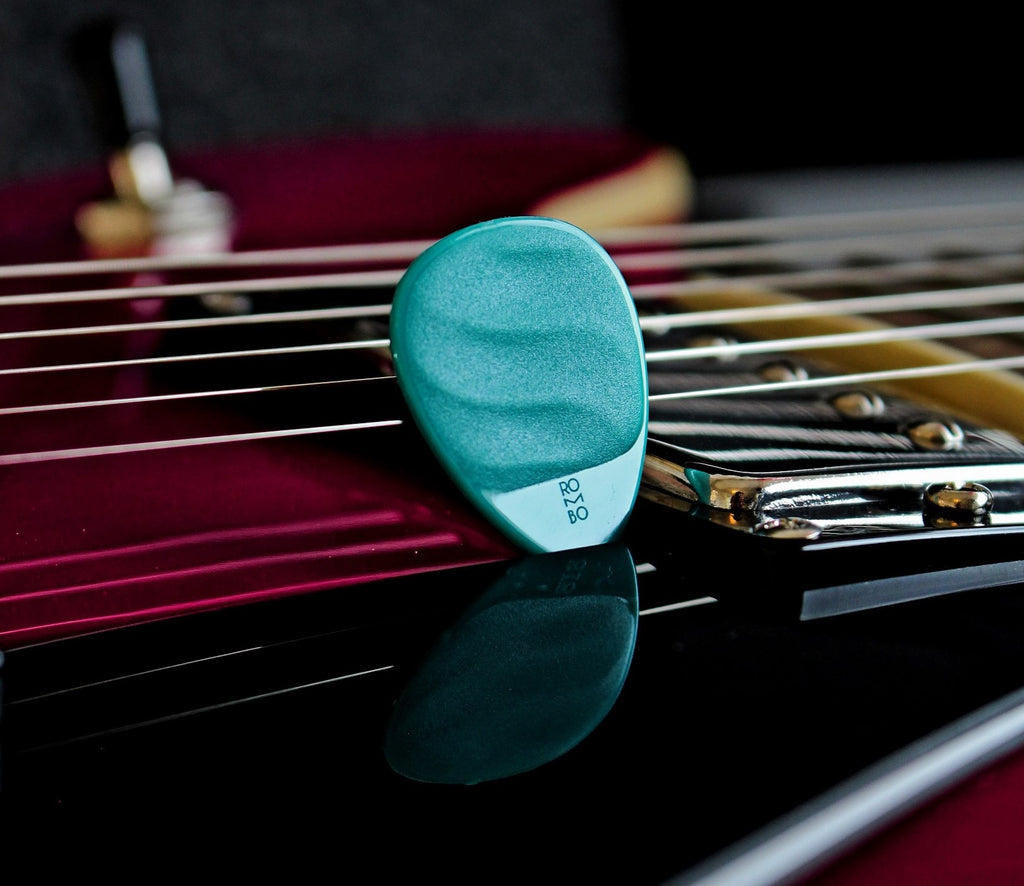
IDEAL GUITAR PICK FOR CLEAR AND DEFINED TONES
Clear and defined guitar tones are produced by pointy pick tips. Ideally, the surface of the tip is polished and has a beveled edge.
Most guitarists prefer small picks for these kinds of tones. Sweep picking, alternate picking, pinch harmonics, and other advanced lead guitar techniques are much easier to perform with such picks.
Depending on your preferences you can then choose different materials: Tortex will increase the attack and create very bright peaks, while Nylon will produce a fuller sound with more bass. Other materials (celluloid, carbon, wood,...) will behave differently.
Rombo Jade is the perfect candidate for speed, control, and attack.

CONCLUSION
Do picks change your guitar tone? Definitely yes!
Not only the tone is affected but other aspects like flexibility, grip, pick noise, attack, or control will be affected by the guitar pick too.
Sound changes will remain as a way of adding some color and dynamic to your music and guitar picks can help you here. With a very low budget and little time, you can experiment and add some fresh input to your daily guitar practice.
The most convenient way of trying many different guitar picks in just one session is by trying a variety pack containing many different guitar picks. Here you can find ours!

Qualities of a premium guitar pick
In our article “How to choose the right guitar pick,” we did a deep analysis on the qualities you should consider when deciding which plectrum to use.
In this article, we will discuss the most important characteristics needed in a guitar pick in order to make the playing experience as comfortable as possible and obtain the best results. These characteristics are not as obvious as others but are essential to getting the most out of this accessory.

1- What is a premium guitar pick?
The Cambridge Dictionary says premium is “used to refer to something that is of higher than usual quality."
Therefore, a premium guitar pick will exceed in qualities like material, shape or texture and will provide a playing experience that’s above average in terms of precision, durability, comfort, tone, or other areas.
Put simply, a premium guitar pick will perform better than regular picks.
1.1 How to achieve premium quality:
Reducing the definition of a guitar pick to its basic intrinsic features, it is easy to understand how to improve certain areas.

For example, it is logical to conclude that better materials will have an impact on the guitar pick’s tone and durability.
Also, with the help of basic ergonomic and design laws, you can create a shape that enhances grip or slides better. The key is to know what you are looking for.
Back in 2018, with the help of a number of professional guitar players, we defined the requirements the Rombo picks had to achieve:
- Excellent tone with minimal pick noise
- Durability
- Comfort and grip
- Great look
- Versatility

With these premises, we started a journey to identify the qualities that would provide an above-average experience in every area.

2- Qualities of a premium guitar pick:
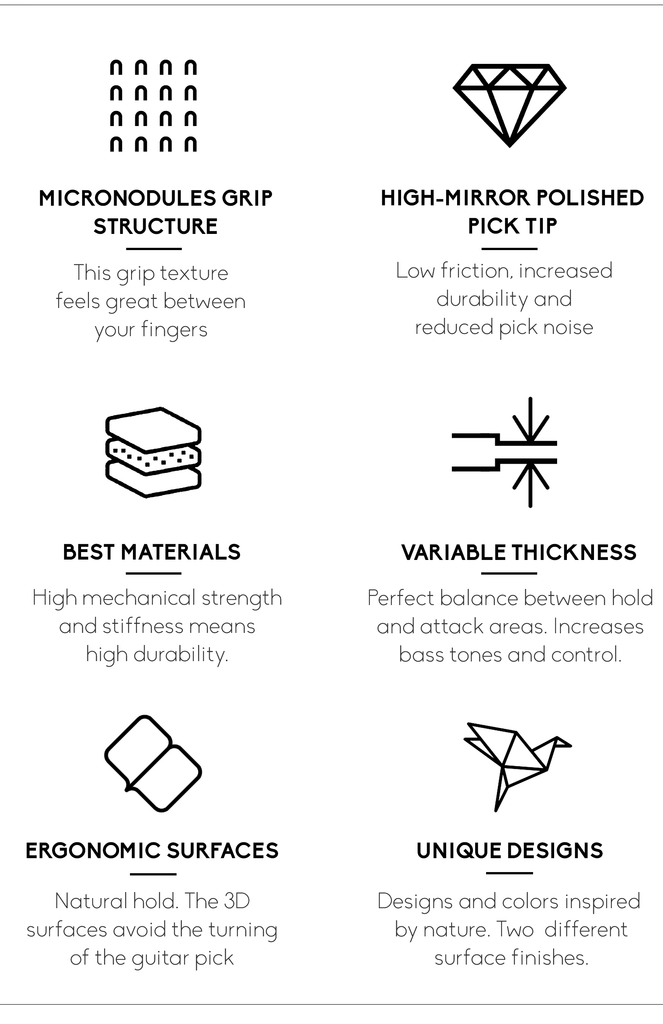
2.1 Micronodules grip texture:
Grippy, non-sticky surfaces are perfect for the guitar pick’s hold area. The best way to achieve this is to create a texture that fits between the grooves of your skin and prevents the guitar pick from slipping or creating an aggressive grip geometry that is uncomfortable for long practice sessions.

When developing the grip texture, our focus was to create a type of grip that allows the player to maintain flexibility and freedom along with a feeling of security and control.
More information on guitar pick grip can be found here.
2.2 High-mirror polished tip:
A guitar pick with a polished tip allows the player to experience more control and less friction. Reduced friction between the plectrum and the strings of the guitar will increase the durability of the pick because it will wear less and reduce its noise.
Noise reduction is a feature especially useful for recording studio tracks.
Furthermore, a polished tip produces more clear individual tones, a requirement for some guitar techniques such as sweep picking.

2.3 Variable thickness:
One of the less common characteristics in guitar picks is variable thickness. It is ideal for the pick to be thick for better control; however, this could significantly reduce its flexibility.
For that reason, plectrums of variable thickness have been created, giving us the best of both worlds.
That is to say, we could have a guitar pick with a solid, thick body that gives us better grip and control. Additionally, it features a thinner tip that provides enough flexibility to achieve greater versatility when developing various guitar techniques.
Remember that an increase in the thickness of only two sheets of paper will substantially reduce the pick’s flexibility!

Read more about the advantages of using a guitar pick with variable thickness here.
2.4 Ergonomic design surfaces:
By following ergonomic models, the surface of the pick can be adapted to feel more comfortable and also look great.
Similarly, we can take advantage of concave or convex surfaces, as they help keep the plectrum’s position oriented and avoid losing control in turning movements.

The shape is also closely connected to the tone of the guitar pick. Just like with the design of a surfboard, you need a specific shape to optimize your energy when catching a wave. The same effect is caused when the guitar pick plucks the strings; different shapes will produce different results.
2.5 High-quality materials:
If your hands are doing an arduous job, then they deserve the best tools, right? Many people spend a lot of money on guitars, amplifiers, strings, and other accessories, but they overlook the guitar pick. This is a big mistake.
The material with which the pick is made can influence the tone, attack, flexibility, durability, and many other aspects. Therefore, without paying attention to it, you can hardly find your personal sound.
Are you curious about the materials used for the Rombo guitar picks? Read a full article on the topic here.

2.6 Unique designs:
The design of everything you own is a way of expressing yourself and defining your personal style.
When it comes to guitar picks, functionality is everything. This is the reason we have spent so much time integrating beautiful geometric patterns that also fulfill the functional requirements for every technique.

3- Conclusion:
In short, guitar picks are personal items that are bound to subjective perceptions. However, some aspects are measurable and can be improved to fulfill requirements that every guitarist needs.
Don’t overestimate this small piece of gear.
Not sure what is the right guitar pick for you? Let us help you here.

Thick Guitar Picks vs Thin Guitar Picks
Thin guitar picks vs. thick guitar picks. This eternal battle has been a part of every guitarist's conversation for decades. It is time to finally evaluate both alternatives in depth.
The thickness of a guitar pick is generally measured in millimeters, and it is an attribute that influences many physical aspects like tone and flexibility. For most players, this is considered the most important attribute when choosing the right guitar pick.

However, after doing some online research, nobody seemed to really know how thick a guitar pick needs to be to be considered as a thick or heavy guitar pick. Where is the line?
Therefore, the first thing we did was to create a big online survey on our Instagram guitar community.
1- What are considered Thick Guitar Picks? Thoughts from the Guitar Community
The survey we created was online for 24 hours on an Instagram story and the participants were asked to answer two simple questions.
Personal preferences - thick picks or thin picks?
This question was the first one, and its aim was to see if guitar players prefer thick or thin guitar picks. Here are the results:

It seems that over two thirds of the guitar players prefer guitar picks considered as thick. Honestly, I thought there would be a 50-50 relation and this surprised me a lot.
What do you consider as a thick guitar pick?
This was the second question, and the guitar players could select different thicknesses they considered to be the “least thickness needed for a guitar pick to be considered as thick or heavy”.

The results showed that on average, a pick must be at least about 1.0 mm to be considered as a thick guitar pick.
These results are very interesting, since the information we found during the research claimed that a pick is considered as “thick” or “heavy” if it surpasses 0.8 mm thickness. We did not find any study or survey with more participants than ours.
Of course, we have to consider that we do not have any way to track more specific characteristics of the participants like skill level, music preferences, guitar type, age, and so on.
Average thickness of guitar picks over time
Additional research on this topic showed that during the past decades, the average thickness of the guitar picks has increased substantially. Thin guitar picks are even considered as vintage by many players due to the tone they produce.
This is no surprise, given that most modern guitar techniques and effects that require thick picks (like shredding) were non-existent during the 1950s and 1960s.

2- Why does guitar pick thickness matter?
The thickness of a guitar pick is one of the most influential attributes.
The guitar pick thickness influences:
- The flexibility of the pick
- The tone produced by the pick
- Volume and body of single notes
- The pick noise created by the pick
- The durability of the pick
- The control over the pick
- The feedback you will receive from the pick
A minimal change in the thickness of a guitar pick of only 0.2 millimeters (equal to two common paper sheets) is enough to change the properties of a guitar pick drastically.

3- Thick guitar picks vs. thin guitar picks:
Let's pretend there are no medium guitar picks and create a clear line that divides both thickness ranges, to make the differences between thick picks and thin picks more appreciable.
|
|
Thick / heavy guitar picks |
Thin guitar picks |
|
Flexibility |
Rigid/very rigid |
Flexible/very flexible |
|
Tone |
Warm/dark tones and mellow tones. |
Lighter tones, less bass. |
|
Volume |
Provide high volume. Broader dynamic range |
Maximum volume is limited. Lower dynamic range |
|
Guitar pick noise |
Reduced pick noise |
Noticeable pick noise |
|
Durability |
More durable |
Less durable |
|
Control |
High control of single notes |
Less control for single notes |
|
Popular techniques |
Lead guitar, shredding, sweep picking,... |
Rhythm guitar, strumming, tremolo picking |
|
Common type of players |
Intermediate and advanced guitarists |
Beginners, acoustic guitar players. |
Thick picks: Summary
Thick guitar picks will provide mellower/darker tones. The common rounded edges that can be manufactured with thicknesses over 1 mm – combined with their rigidity – increase the bass tones and the volume these guitar picks can provide, while reducing the pick noise the pick produces.
These picks provide more control over single notes and are usually the best option for lead guitarists.

Most advanced guitarists prefer thick picks, because in their guitar journey they develop new guitar techniques that can be performed better using this kind of picks. Thick plectrums provide more control when it comes to single notes and complex guitar pick techniques like pinch harmonics.
One of the biggest advantages of using heavy picks is the durability they provide. Nevertheless, the lifetime of a guitar pick is influenced by many other aspects, as we learnt in the article “Durability of a guitar pick”.
Thin picks: Summary
Thin picks are the best option for guitarists looking for brighter tones, especially using acoustic guitars and some strumming techniques on electric guitar.
The flexibility of these picks limits the maximum volume that can be achieved. This can be an advantage because it works like an analog limiter. This is especially helpful in a studio session, where the maximum volume achieved must be controlled.

Most beginner guitar players start using thin picks because their guitar skill set at the beginning includes guitar techniques like strumming.
Note control can be difficult with thin guitar picks. However, some players use this attribute for specific guitar techniques, like in surf music, where a super fast tremolo picking is required.
4- Example of a thick guitar pick: Rombo Jade
Rombo Jade is the perfect example of a thick guitar pick. Thanks to its thickness, a very large bevel edge could be implemented to be as sharp as possible, providing the precision needed when using these kinds of picks.

The size is small, a typical attribute of thick guitar picks, and its shape ends with a very pointy guitar pick tip for maximum attack.
5- Example of a thin guitar pick: Rombo Classic
Rombo Classic is the thinnest Rombo guitar pick. In the middle, it is only 0.38 mm.
This guitar pick is extremely flexible and has a medium/large size with a standard 5 mm diameter guitar pick tip.

In spite of its thickness, the dynamic range of the pick is great. This is caused by the material used in our picks.
6- The right guitar pick thickness for you
I am sure you already have an idea of your favorite guitar pick thickness. In case you don’t, it is probably because you are at the beginning of your guitar journey.
Is there a wrong guitar pick thickness to play guitar? Any pick you use to get sound out of your guitar can work, if the sound produced is the sound you are looking for. It is entirely a matter of personal preference.
If you are a beginner guitar player, I recommend you start with something like 0.75 mm, as I described here: "Guitar Picks for Beginners"
However, if you are an intermediate player trying to find a way to discover new guitar tones, I do not have better advice than to tell you to try many different thicknesses and start integrating other important aspects of the guitar pick in your decision, like materials, size, shape, etc...

The good news is, you will probably end up having 3 to 5 favorite guitar picks which you can use for different techniques. So, enjoy the journey and be open to experimenting with different tones and textures with your guitar!
7- Current guitar pick thicknesses at Rombo:
For this chapter I included the new guitar picks, which will be officially released during 2021.
As you can see on the thickness scale, there are still some slots missing (for example something like 0.6 mm), we will be filling them in the future, as we design new guitar picks.

However, we might repeat thicknesses if other aspects change a lot, for example the shape, the sharpness of the tip, the size of the pick, or other grip textures.
8- Variable guitar pick thickness
Another important factor to consider is that some picks do not have constant thickness along its design. But why?
As we did our research back in 2018, we found out that designing guitar picks with variable thickness comes with many advantages.
Let's take Rombo Origami as an example: The guitar pick tip is 0.75, but its hold area is thicker. This simple change makes the pick produce darker and mellower tones without losing much of its flexibility.

In the case of Rombo Diamond, the middle area (where all vertices collide) the thickness goes up to 2.65 mm. We increased this area after experiencing that the relation between the thicknesses along the guitar pick also increases the control over the pick for single notes.

In addition, with more thickness on a given material, you have more possibilities to introduce design elements, like the 3D geometries we use in our picks. These geometries have two positive effects: on one side, they enhance the grip of the pick because of the tilted surfaces, and on the other side, the guitar picks look very cool!
In short, variable thickness will make your picks more versatile and give you extra control.
9- Conclusion
Thick picks vs. thin picks will remain a hot, trendy topic in the guitar community.
However, if you are already an intermediate player with some knowledge about equally important aspects of a guitar pick like shape or material, spread the word to avoid confusion among the newcomers.
We have already discussed the huge variety of different guitar picks you can find online in our article “Guitar picks online” since this can be overwhelming for some beginners.
The best advice I can give you: love both thin and thick picks and try to understand why they are different. Both need to exist in a world where creativity and different tones and styles are needed!
Now it’s your turn, what is your favorite guitar pick thickness?

Guitar Pick Deep Analysis: Rombo Diamond
Guitar picks can be found in all shapes, colors, and materials. These small items used for specific guitar techniques can offer different tones, dynamic ranges, and ergonomics, and therefore create a totally different playing experience depending on the pick you use.
The aim of this series of articles is to inform you in detail in a way that you wouldn’t find anywhere else. We want you to understand why we do what we do. So relax, hold your tea, and enjoy our first deep analysis on the guitar pick Rombo Diamond.
1 - Guitar pick Rombo Diamond: Overview

Exceptional picking control and accuracy. Favorite amongst advanced guitarists. The hole in the middle provides extra control and grip rate. Sharp tip for high attack, and clean bright tones.
2 - Guitar Pick Geometry Analysis
Guitar pick size
With its 28,4 x 25,5 mm, Rombo diamond can be considered a small-medium sized guitar pick.
Small guitar picks have several advantages: They perform exceptionally when practicing speed and are perfect for shred techniques.
With small-sized plectrums, your fingers are closer to the strings and you get more feedback from your guitar playing.
The downside of these picks is that they can be dropped easily. This is the reason we decided to increase the size of Rombo Diamond a little bit and make it small-medium. The first prototype was only 25 mm high.

Furthermore, we decided to increase the width to match the regular size of a thumb.
Guitar pick shape
The shape of a guitar pick is often overlooked. However, in the case of Rombo Diamond, thanks to its form and the pointy guitar pick tip, the attack and the control are substantially increased.
The pointy guitar pick tip, with only 3 mm in diameter, was designed to provide maximum note control.



The angle of the tip is wide enough to let your guitar strings slide longer.
Rombo Diamond has a slight bevel edge, mainly used to increase the guitar playing speed.
With a rounded bevel like this, the attack of the guitar pick gets smoother, a feature that changes the feedback you receive when you use specific techniques.
This is only possible for guitar picks with enough thickness, and it is very popular because of the feeling of easiness it provides while playing guitar.
Guitar pick thickness and guitar pick flexibility
The guitar pick thickness mainly defines how flexible a guitar pick is. However, other aspects like tone and ergonomics are mostly influenced by the thickness of the pick.
Rombo Diamond has guitar pick variable thickness along its body. This means that this guitar pick has different thicknesses for the hold area and for the tip area.

The thickness of the tip is 1,35 mm, providing enough space for the bevel edge mentioned before. This can be considered as a heavy/thick guitar pick.
The thickness of the hold area varies due to the diamond design. At the highest point, right in the middle where all the vertices create the diamond design, it is 2,65 mm thick.
The variable thickness on Rombo Diamond has been implemented primarily for two reasons:
It increases the feeling of control because the pick is easier to hold
It increases the bass tones, creating a much thicker tone
Both dimensions create a very rigid guitar pick.
The thickness of a guitar pick is also an essential factor in terms of durability. The shape and bevel combined with the polished tip and its thickness make this pick very durable.
3 - Guitar pick Materials and Surfaces
Guitar pick material
The material of a guitar pick is strictly connected to its flexibility and tone.
Rombo Diamond is offered in the Rombo polymer and the EcoBlack polymer, which offer the same characteristics.
The polymer we use is an improved variation of nylon designed to increase the durability and cause some tone changes. It is manufactured in Italy.

Since we use the same material for all our guitar picks, this part of the analysis will be skipped. We have already created an extended article regarding the materials that can be found here.
Guitar pick design
The Guitar Pick design is obviously inspired by a diamond shaped geometry. Rombo Diamond was meant to be hard, durable and rigid, therefore this design matches its mechanical attributes very well.
The functional surfaces were distributed in a way to enhance the diamond form. The grip area in the middle makes the diamond visible, while the polished areas give the shape and tip more optical clarity.

As we will see in the next chapter, the 3D surfaces were designed as functional surfaces to improve the grip. However, with the first prototypes, we realized that this was a very nice way to explore more design nuances.
Guitar pick grip
For the grip of Rombo Diamond, there are three aspects to consider:
The material
The 3D Geometry The micro-nodules texture
The micronodules texture is the texture we developed to create a comfortable grip. Usually, this texture wouldn’t be enough for a good grip and for this reason, we incremented the grip using the right material and 3D surfaces.
The 3D surfaces with the shape of a diamond have different thicknesses and tilted angles that fold the surface in different directions. This increases the grip substantially and avoids the rotation of the pick while playing.
For the people who like to hold the pick on the back side, we created a tunnel to compensate for the thickness reduction this area has.

We consider Rombo Diamond to be a pick with medium grip.
Guitar pick colors
Currently Rombo Diamond is offered in the following colors.

Manufacturing technique
Rombo Diamond is manufactured using an engineering technology called injection molding, in which melted polymers are forced to fill a mold and get a specific shape.
After that, there is a small mark called “the gate” in the back of the pick, which is where the melted material flows through to enter the mould. After the production, this manufacturing mark is treated by hand to make it smaller and less visible.
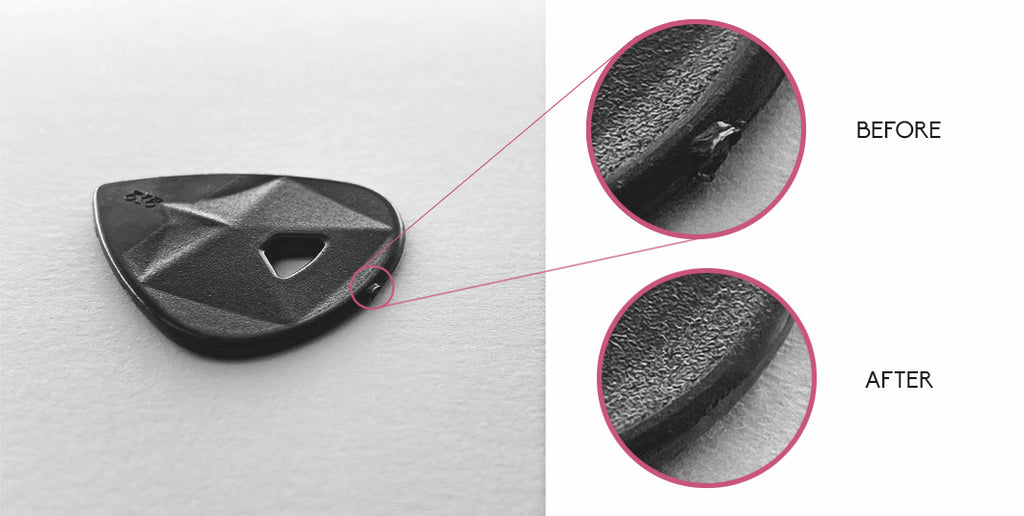
The borders of the pick have a parting line which is also removed post-production to increase the quality of the borders of the guitar pick.

Rombo Diamond is manufactured by automatic processes. However, a post treatment by hand is necessary to achieve the quality Rombo pursues.
4 - Guitar pick sound
Guitar Pick tone
So far, we have defined Rombo Diamond as a very thick, small-medium guitar pick, with a sharp tip. These are the typical characteristics of a pick that produces very bright tones.
However, due to the variable thickness mentioned before, we incremented the dynamic range of the guitar pick, allowing the player to enjoy some bass dark tones as well.
Usually, guitar picks with a very heavy attack can reduce the sustain of your guitar tone. With these small thickness changes we solved this problem.
The polished guitar pick tip, combined with its shape, enhances the bright tones and allows you to play some of the harmonic techniques on an electric guitar more easily.
The bevel edge can create those beautiful thick and compressed tones that we all like for distortion and overdrive.
Rombo Diamond is a pick that produces bright and clear tones, but with slightly dark shades in the background, which makes the sound richer and more complete.
Guitar Pick Noise
Because of the integrated bevel edge, the material toughness, the shape, the pointy polished tip, and the thickness, we consider Rombo Diamond to be a guitar pick that creates lower pick noise.

5 - Guitar pick techniques
Rombo Diamond was designed for the advanced player who likes speed, volume, attack, and control, but still wants a sophisticated tone and more than just power.
It is mainly intended for electric guitars.
Arpeggios and shred techniques like sweep, alternate, and tremolo picking are good examples of techniques which can be improved using the right guitar picks.
For strumming and palm mute, using Rombo Diamond can give you a much thicker and complete sound creating a bigger atmosphere when playing guitar.
6 - Pricing
Rombo Diamond is currently offered only in guitar pick sets containing four guitar picks in different color combinations and a packaging card with extra information about the pick attributes.
This pick is also included in the Variety Pack from Rombo, with other guitar pick models.
7 - Conclusion
Size: Small-Medium
Shape: Pointy tip, sharp attack angle
Thickness: Heavy with variable thickness. Hold area: 2,65 mm - Attack area: 1,35 mm
Materials: Rombo Polymer and EcoBlack
Durability: Very high
Design: Diamond Design with two different surface types.
Grip: Medium, micro-nodules combined with 3D Surfaces
Colors available: Graphite Black, Water Blue, Strawberry Red, Honey Yellow, EcoBlack
Manufacturing technique: Injection moulding and hand processing of the borders.
Tone: Bright, clear tones with a bass nuance on the background caused by the geometry.
Pick noise: Low
Techniques: Mostly electric guitar. Lead guitar techniques and high volume distortion.
Pricing: Guitar Pick Set Rombo Diamond

Picks vs. Fingers for Playing Bass Guitar
You have probably heard this question many times: Should I use a pick or my fingers to play bass? You can find a huge amount of different answers on the Internet and still be confused.
My philosophy is, to never limit yourself. Both methods are valid and appropriate for the right musical context.
Picks vs. Fingers: The Eternal Debate
Whether using picks or using your fingers, each technique has its place and, ideally, you need to feel comfortable with either one you choose.
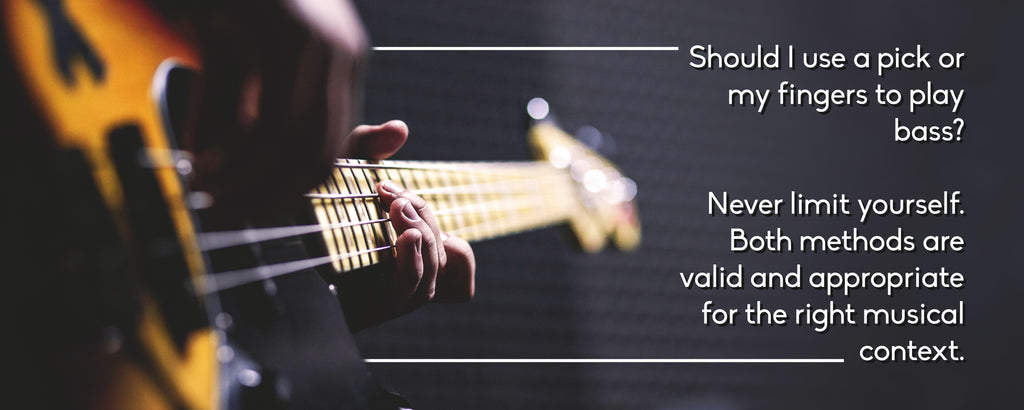
Is there a wrong way to play an instrument? Any method you use to get sound out of your instrument - fingers, pick, nails, palms of your hands, etc - can work, if the sound produced is the sound you are looking for. It is entirely a matter of personal preferences.
Therefore, this is an unimportant debate, if your plan is to be a versatile musician, and be able to understand the rich parts of every bass line, regardless of the method used to play them.
For me, it is difficult to understand how this debate has been one of the most controversial topics since the advent of modern music creation decades ago.
Why not keep an open mind and become comfortable with both methods? There is room for everything.
Using Fingers to Play Bass
Usually, bass players report having more control when using their fingers, giving them a richer tonal variety, and beefier tone. In Addition, the popular slap technique used by many bassists can be easily implemented, if you don’t hold any pick between your fingers.

A funny positive argument is, that you will never lose your bass pick if you don’t own one.
One of the drawbacks of this method is that it takes a little more work to learn. Nevertheless, if your goal is long-term learning, this should not be a technical obstacle.
Using Picks to Play Bass
The biggest advantage of using a pick for the bass guitar is obvious: Instant speed. You can develop speed more quickly and effortlessly.
If the bass lines you want to learn, belong to certain music styles that are speed intensive, a pick might make sense. You can develop the same speed as with your fingers, but it will take much more time.
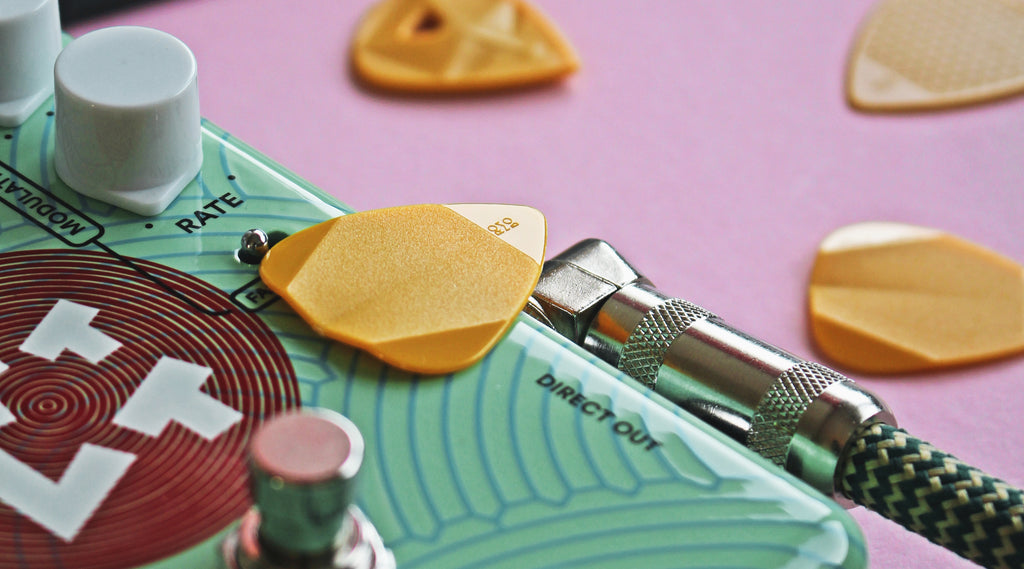
In addition, the tone can be easily changed by using a different guitar pick. This allows you to have different tones, and experiment a lot to find the right sounding bass guitar pick.
Every pick - for guitar, bass, or other instruments - has four different main parameters: Shape, material, thickness, and size. Combined together, they result in a very specific range of tone textures, attack soundwaves, and feedback. Therefore, choosing your guitar pick is one of the most difficult tasks. We have created a guide HERE, that will help you find your tone.
Pick Thickness for Bass Players
Bass players generally use thicker picks. The thickness improves the bass playing control, and the overall tone of the string.
The average pick thickness for bass players is 1.17 mm, while for guitar players is 0.89 mm. Remember, bass strings are much thicker than guitar strings. Therefore, a thinner plectrum will give you much less control in comparison to a thicker plectrum.
The size of the pick will also have a role in the creation of the tone.


Having said that, there are still many bassists who do prefer to use thinner bass picks, like for example Rombo Classic, or Rombo Origami.
If you have no idea where to start, take the average value and look for picks with a gauge of about 1.2 mm. This is a good place to get started. From there, you can go up and down and try other picks depending on your preferences. It might be a good idea to look for the bass picks your favorite players use, and try to understand why they do so.
Most Popular Pick Shapes for Bass:
The truth is, most classical shapes tend to have an excellent reception between the bass players.
The most popular shapes are the classical teadrop pick shape, the rounded teardrop pick shape, and the triangle pick shape.
In addition to shape, there are many other attributes that define a pick. HERE you can read about the 6 most underrated attributes of guitar and bass picks.
Teardrop
Teardrop is the most popular and known type of guitar and bass pick. Semi-sharp point for quick attacks, that maintain a wide range of possibilities, depending on the thickness and material used.
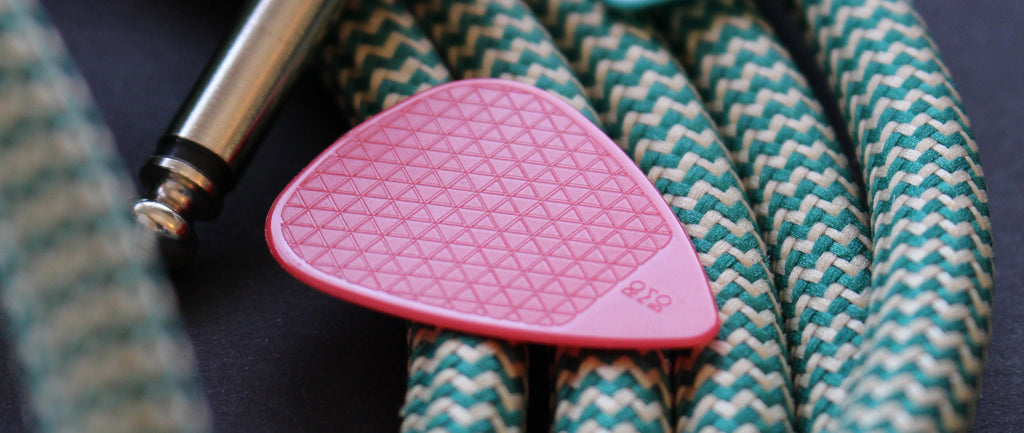
Rounded
Rounded picks provide a more warm sound and smooth attack. These are for the bass players looking for a way to play the bass strings with less force and attack. Sometimes they are totally free when a teardrop pick is completely worn down.
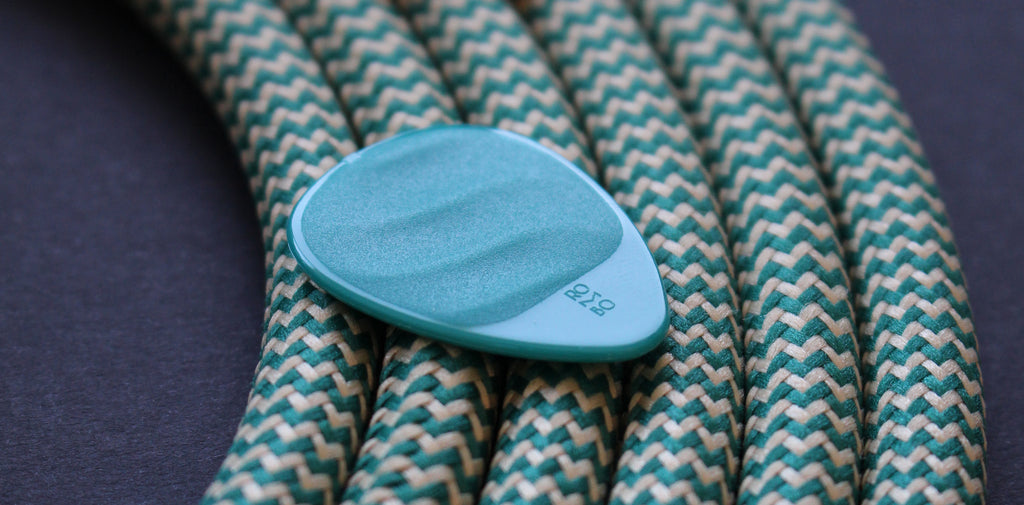
Triangle
A triangle pick is the most practical option because of the tri-sided feature. You can pluck your string with any of the three pointy tips this pick provides. A triange pick is recommended for those players who constantly break the tips of their picks.

Pick Materials for Bass Players:
When it comes to bass, we apply the same rules as with guitar picks.
After studying the physics of guitar picks, and all the material possibilities we have, we came to the following conclusions. The pick material should:
- feel nice to the touch and be comfortable, yet provide grip
- be able to create clear tones, without compromising the bass tones
- be very versatile: feel flexible when thin, and feel stiff when thick
- be durable
- look nice

You can read all about materials used at Rombo HERE.
You will also find a link with the information about Eco-Black - These picks made out of 100% recycled fibre waste, that we manufacture ourselves.
The durability of Bass Picks:
Because the strings are thicker, and bass players tend to play with more energy, the lifetime of your pick will be substantially reduced.
A way to reduce the wear and tear of picks for bass is:
- Using thicker picks
- Using harder materials
- Using picks with polished tip
- Using triangle picks (3 tips take longer to wear down).
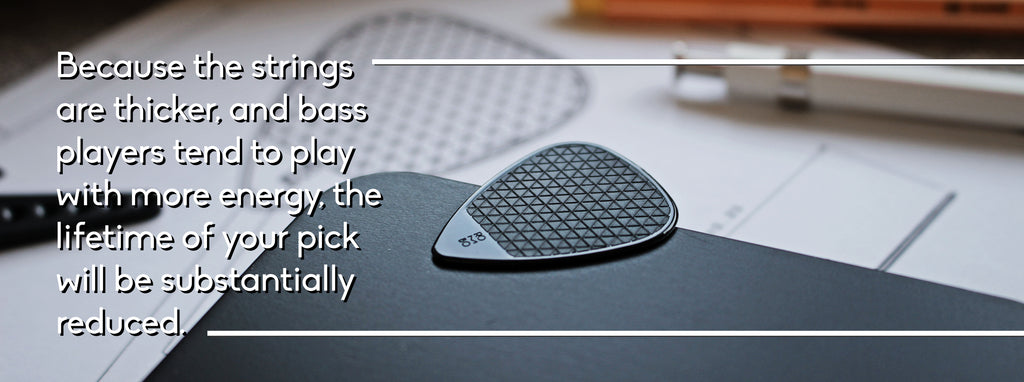
Conclusion:
Playing bass with a pick is as valid as using your fingers, if this is the tone you are looking for.
Finding a pick you are comfortable with, is a difficult task, but testing lots of them and recording some of your bass lines can help you find a balance between the tone you want, and the feel and feedback you wish from the pick.
In picks, qualities like thickness, material, shape, and size play a pivotal role in tone, feedback, grip, pick noise, sustain, etc... Music is about staying dynamic and monotony kills dynamic. Therefore, the most logical step for you is to explore enough to understand as many aspects of the bass as possible.
This applies to guitar gear in general (including picks, strings, cables, etc...) and your practice habits, style preferences, and your own psychological bias/barriers.
Sometimes the best place to start is testing a Variety Pack

- Shop
- Dealers
- Legal Notice
- Terms of Service
- Refund Policy
- Shipping
- Privacy Policy
- Contact us
- Press
- FAQ
Sign up to get the latest on sales, new releases and more…
By signing up you agree to our privacy policy.
© 2024 ROMBO.
registered brand
Powered by Shopify


